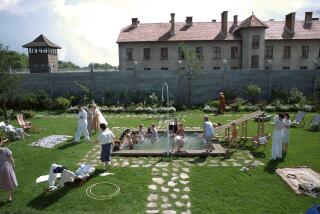Werner Herzog’s walking blues
- Share via
“Why is walking so full of woe?” Werner Herzog asks early in “Of Walking in Ice: Munich-Paris, 23 November – 14 December 1974” (University of Minnesota Press: 128 pp., $19.95 paper), a diary of sorts describing a 600-mile trek through winter that he undertook 40 years ago.
If this sounds quintessentially Herzog, quintessentially quixotic, so be it; in his films — most notably, perhaps, the hallucinatory “Fitzcarraldo” and “Aguirre, the Wrath of God” — he traces the price, and power, of obsession to both ennoble and dismantle us. Something similar is at work in this slender book, originally published in 1978 and newly restored to print.
The inspiration for the project is a phone call Herzog received in late 1974, informing him that a friend, the German film historian Lotte Eisner, was close to death in a Paris hospital. As an act of expiation, then, or maybe magic, Herzog decided to walk from Munich to Eisner’s bedside, as if, through such his relentless movement, he might keep her alive.
Indeed, Eisner lived for nearly a decade more. The power of “Of Walking in Ice,” though, has to do with Herzog: his solitude, his observation, the way he is both bent by and bends landscape to his will.
Here he is outside Kirschheim, in the first days of his trip: “The countryside’s so empty and has the same forsaken sense for me as during that time in Egypt. If I actually make it, no one will know what this journey means.” He is talking to himself, but also to all of us, which is, of course, what a published diary does.
In some sense, actually, this is a book four decades ahead of its time, since we now live in a diaristic present: Knausgaard, Sarah Manguso and Heidi Julavits come to mind.
Herzog, however, is after something different — not only the passage of mundane daily experience, but also the passage into the transcendental, the space between exterior and interior, physicality and spirit, which is where his imagination resides.
Late in the diary, he tells the story of a Spanish priest “reading Mass in bad English” — an anecdote that ends when “a pale young girl collapsed on the steps and died. Someone daubed cool water on her lips, but she preferred Death.”
The implication is that we are always making choices, decisions, that mortality is less a state of being than a state of mind. This, in turn, brings us back to the intention, magical or otherwise, of the walk itself.
If that suggests we read “Of Walking in Ice” as metaphor, it is both more and less than that.
On the one hand, Herzog’s observations of the countryside are delicate, steeped in history; “The forest slowly ends here,” he writes, from just inside the French border, “the fierce hills, too. For many, many miles, uninhabited woods sprawl all around, woods that served as battlegrounds in the First and Second World Wars.”
At the same time, history is just a gloss, a narrative, superimposed over the moment-to-moment experience of being on his feet.
For Herzog, walking is an act of opposition, not just to the static culture of the towns through which he passes, but indeed to death itself. As long as he is in movement, in transit, he can’t be pinned down, which means that he remains alive.
Not only that, but Eisner does also; by book’s end, in fact, it’s hard to say who’s sick and who’s the savior, him or her.
“I went to Madame Eisner,” he notes in the final entry; “she was still tired and marked by her illness. Someone must have told her on the phone that I had come on foot. I didn’t want to mention it. I was embarrassed and placed my smarting legs up on a second armchair, which she pushed over to me. … Then she looked at me and smiled very delicately, and since she knew that I was someone on foot and therefore unprotected, she understood me. For one splendid, fleeting moment something mellow flowed through my deadly tired body. I said to her, open the window, from these last days onward I can fly.”
twitter: @davidulin
More to Read
Sign up for our Book Club newsletter
Get the latest news, events and more from the Los Angeles Times Book Club, and help us get L.A. reading and talking.
You may occasionally receive promotional content from the Los Angeles Times.









